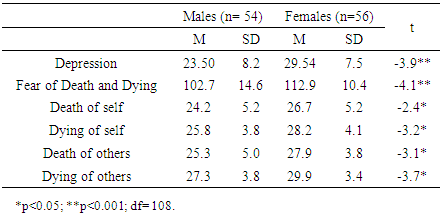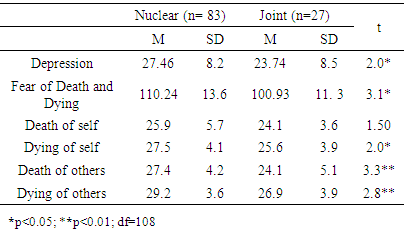-
Paper Information
- Paper Submission
-
Journal Information
- About This Journal
- Editorial Board
- Current Issue
- Archive
- Author Guidelines
- Contact Us
Journal of Health Science
p-ISSN: 2166-5966 e-ISSN: 2166-5990
2017; 7(2): 21-24
doi:10.5923/j.health.20170702.01

Myocardial Infarction: A Conjunction of Death Dread and Depression among Married Men and Women in District Gujrat
Sabeen Fatima 1, Sameera Shafiq 1, 2
1Department of Psychology, University of Gujrat, Gujrat, Pakistan
2Alumni National Institute of Psychology, Quaid-i-Azam University, Islamabad, Pakistan
Correspondence to: Sameera Shafiq , Department of Psychology, University of Gujrat, Gujrat, Pakistan.
| Email: |  |
Copyright © 2017 Scientific & Academic Publishing. All Rights Reserved.
This work is licensed under the Creative Commons Attribution International License (CC BY).
http://creativecommons.org/licenses/by/4.0/

The aim of this study was to investigate the level of fear of death and depression among heart patient, explore the predictive relationship between them, and to assess differences with respect to gender and family system. The level of fear of death and depression was assessed in a sample of 110 heart patients selected by purposive sampling technique including 56 females and 54 male with their informed consent from different hospitals of Gujrat. The Urdu version of Revised Collett-Lester Fear of Death and Dying Scale [1] was acquired by forward-backward technique translation technique. Depression Checklist based on Aaron T. Beck’s work was used for collecting the data. Findings revealed high levels of fear of death and depression among heart patients with a significant positive correlation coefficient (r=0.55; p<0.001) for fear of death predicting (β= 0.54; p<0.001) depression. Females have significantly more fear of death (t= -4.0; p<0.001) and high level of depression (t=-3.9; p<0.001) than the males. Heart patients living in nuclear family systems have greater of fear of death (t=3.1; p<0.05) and higher depression (t=2.0; p<0.05) than those living in joint family systems. This research has crucial implications for psychologists and cardiologists to develop intervening strategies for better rehabilitation of heart patients facing the dilemmatic reality of near to death fear and depression along with their chronic disease, in the field of health psychology especially with reference to Pakistan.
Keywords: Depression, Myocardial Infarction, Distress, Health Psychology
Cite this paper: Sabeen Fatima , Sameera Shafiq , Myocardial Infarction: A Conjunction of Death Dread and Depression among Married Men and Women in District Gujrat, Journal of Health Science, Vol. 7 No. 2, 2017, pp. 21-24. doi: 10.5923/j.health.20170702.01.
Article Outline
1. Introduction
- Nowadays, coronary heart diseases (CHD) have topped the etiological chart of mortality among men and women globally [2]. The main determinants behind CHD are considered to be obesity, blood pressure, hyperlipidaemia, and diabetes mellitus [3]. A prominent disease among CHD is Myocardial Infarction that is primarily considered to be a biologically originated disease due to hypertension and obesity. However, there is another side of the picture that needs proper attention and empirical investigation, namely, the psycho-social aspects (comprising mainly of the self and the others) contributing to the havoc of myocardial infarction. The objectives of the present study are to assess the level of fear of death, the level of depression, and predictive correlation in the heart patients. In addition the gender and family systems are explored with respect to the death dread and depression. Therefore, a missing link of psycho-social dimension in biomedicine of heart attack is a crucial investigative point in the present empirical research. Life and death are the integral part of one’s life. The former is a celebrating event for us but the latter has become a dread due to existential fact that we all have to face death inspite of advanced medical technology and medicines. Therefore, it led us to realize our nothingness and no-control situation over physical entities. Death dread is understood as “the extent to which one experiences angst in reference to death” [4, p. 39]. The denial of this crude fact led to the metaphysical anxiety and consequently resulted in aggression and depression. Therefore, death dread, death anxiety and fear of death are unanimously used as interchangeable terms for the same bitter fact of avoidance to face harshness of nothingness or more precisely death. Freud’s concept of Thanatos and related extensions of Thanatophobia and Thanatology have resulted in empirical investigation into the subject matter to help people deal with death dread.The levels of death anxiety are experienced and expressed variedly not only across cultures but also among individuals [5]. There are personal perceptions about the meanings of what it is to be a dead and the individual’s is relation to that schema, might give rise to the fear of death [6] consequently ensuing in stress, sadness, and depression. Significant relationship between depression and cardiovascular diseases has been explored among various studies [7-9]. Mood disorder, more precisely depression is considered to be, “A low, sad state marked by significant levels of sadness, lack of energy, and guilt” [10, p.191]. The symptoms of indecisiveness, uncontrollable sobbing, and feeling of despair, anger and worthlessness, often exacerbate life areas of functioning. They consider themselves inadequate, undesirable, and inferior. They considered themselves responsible for every unfortunate event [10]. This is the aspect where psychologists could intervene with the patients by providing psycho-educational sessions and relieving their somatic pains and miseries. So far as the influence of gender and family system is considered, women have been found to score higher on the death anxiety than men. It is contributable to their empathetic nature with dying, while grieving with people for the dead one to help them in coping with regrets of the lives and at the same time internalizing fear themselves [4]. Likewise, empirical evidences have highlighted the substantially high prevalence rate of depression among women than men [11]. Moreover, the people living in a nuclear family system suffered more from depression than those living in a joint family system [12]. The general hypotheses of the present study are: i) Heart patients will have high level of fear of death and depression as positively correlated; thereby the former will predict the latter variable. ii) Females will have more fear of death and depression as compared to males in heart patients. iii) Heart patients living in nuclear family system will have high level of depression and death dread than heart patient living in joint family system.On one hand, the prevalence of Myocardial Infarction in Pakistan has been seen to be at its peak [13, 14] and on the other hand, the death anxiety has been more searched out topic in Western cultures. This study is helpful to understand the relationship between the depression and the fear of death among the heart patients. The findings of this study understanding of death anxiety and depression levels among would be fruitful for the health care providers with an increased the heart patients who may contribute to improvement among heart patients by providing better treatment and support. The betterment in the treatment, development of preventive and intervening strategies for the support of the patients and their families might lead toward decreased levels of the depression and the fear of the death among the heart patients.
2. Method
2.1. Sample
- A sample of 110 heart patients, comprising of 49% males and 51% females (age between 35 to 72 years) were drawn by using purposive sampling technique from Aziz Bhatti Shaheed Hospital and Gujrat Hospital. The inclusion criterion was based on the informed consent of the married patients diagnosed with Myocardial Infarction irrespective of stage and chronicity, to participate in the study. The participants were either educated (primary-middle: 20%; matric-intermediate: 35%; bachelors-masters: 11%) or un-educated (34%), having different occupations such as being shopkeepers, farmers, teachers, and businessmen.
2.2. Instruments
- Depression Checklist based on Aaron T. Beck’s work on depression was used to measure the level of depression among patients with myocardial infarction in Urdu. Collett-Lister Fear of Death and Dying Scale (English Version) [1] was used after translating in Urdu.
2.3. Procedure
- In Phase I, Collett-Lister Fear of Death and Dying Scale (English Version) was translated by a panel comprising of four bilingual experts (one clinical psychologist, two psychologists, and one English Literature Expert). The final Urdu versions were selected after evaluation of one best Urdu translation and reversing to English via back translation. In Phase II, questionnaires were delivered to respondents of different hospitals of the Gujrat. After taking verbal informed consent, the instructions were read and repeated from the scales verbally. Participants were assured that their responses would remain anonymous. Some respondents were illiterate; therefore, they are unable to fill the measurements by their own. For them, the questions were read in Urdu and the answers of the respondents were noted down.
3. Results and Discussion
- The descriptive and inferential statistical analysis on the data collected has been given below:
|
|
|
|
|
4. Conclusions
- The findings revealed a significant positive correlation coefficient between fear of death and depression among heart patients. Females have significantly more fear of death and depression than males. Heart patient living in nuclear family system have higher levels of fear of death and depression than heart patient who are living in joint family system. Therefore, fear of death has predicted the level of depression among them. This research is helpful for consideration in same direction for further researches and has crucial implications for psychologists, social workers, nurses, and cardiologists to develop intervening strategies for better rehabilitation of heart patients facing underlying co-morbid fear of death and depression.
 Abstract
Abstract Reference
Reference Full-Text PDF
Full-Text PDF Full-text HTML
Full-text HTML



